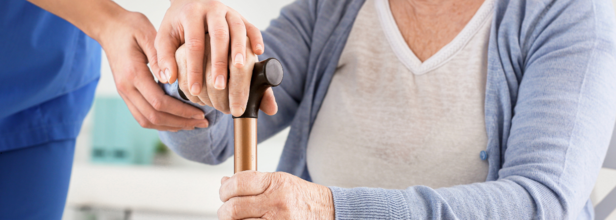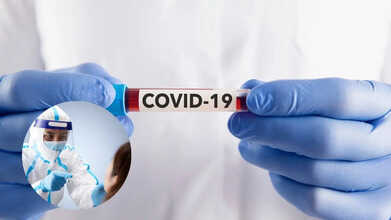- Health Conditions A-Z
- Health & Wellness
- Nutrition
- Fitness
- Health News
- Ayurveda
- Videos
- Medicine A-Z
- Parenting
- Web Stories
New Research Suggests That Parkinson's Disease Cases May Increase By 112%

Credits: Canva
A new study published in the journal BMJ, titled Projections for prevalence of Parkinson’s disease and its driving factors in 195 countries and territories to 2050: modelling study of Global Burden of Disease Study 2021, estimated that by 2050, 25.2 million people will be living with Parkinson’s disease worldwide, marking a staggering 112 percent increase from 2021.
The World Health Organization (WHO) estimated that 8.5 million people worldwide were living with Parkinson's disease in 2019. This rise has called in for urgent need for better research for its treatment options and public health strategies to manage the disease's growing impact.
Why Is There An Increase?
The reasons are based on their findings on the data from 2021 Global Burden of Disease Study. This has been analyzed from 195 countries and territories. It found that aging and population growth were identified as the primary reasons to be projected in the rise of Parkinson's disease. There are of course other regional and national variations in the growth rates.
“By 2050, Parkinson’s disease will have become a greater public health challenge for patients, their families, caregivers, communities, and society,” the study states.
What Are The Regional Differences?
The study projects that East Asia will have the highest number of Parkinson’s disease cases in 2050, with an estimated 10.9 million people affected. South Asia follows closely with 6.8 million projected cases. Meanwhile, Western sub-Saharan Africa is expected to experience the largest percentage increase in cases—rising by an astonishing 292 percent from 2021. In contrast, Central and Eastern Europe will see the smallest increase, at 28 percent.
The authors also noted that Parkinson’s disease prevalence is rising more sharply in men and in moderately developed countries, particularly in East Asia. The exact reasons for this disparity are still being explored, but potential factors include environmental exposures, lifestyle changes, and genetic predisposition.
ALSO READ: Common Parkinson's Drug Tied to Risky Sexual Behavior, Say Patients
What Is Parkinson's Disease?
It is a progressive neurodegenerative disorder that affects movements and causes symptoms such as tremors, muscle stiffness, slow movements, and balance difficulties. This happens when nerve cells in the brain stop producing dopamine, which is a chemical important for coordinating movement.
While the exact cause of Parkinson’s remains unknown, researchers have identified several risk factors, including genetic mutations, exposure to toxins, and head injuries. Age remains the most significant risk factor, with most cases occurring in individuals over 60.
Parkinson's Disease affects various brain regions but the primary symptoms arise from the degeneration of neurons in the substantia nigra, a region near the brain's base. This area is crucial for producing dopamine, a chemical messenger essential for smooth and purposeful movement. Research indicates that by the time Parkinson's symptoms become evident, patients have typically lost 60 to 80% or more of these dopamine-producing neurons.
Additionally, individuals with Parkinson’s disease experience a reduction in nerve endings that produce norepinephrine, a neurotransmitter responsible for regulating many involuntary bodily functions, such as heart rate and blood pressure. This loss may account for some non-movement-related symptoms of Parkinson’s, such as fatigue and fluctuations in blood pressure.
Parkinson’s disease also involves the presence of Lewy bodies—abnormal deposits of the protein alpha-synuclein within affected brain cells. While the exact role of Lewy bodies in Parkinson’s is still unclear, some research suggests that disruptions in the cell’s protein disposal system may lead to the accumulation of harmful protein levels, eventually causing cell death. Other studies propose that these protein clumps could contribute to the degeneration of neurons in the disease.
World Heart Day 2025: How Accurate Is an ECG in Detecting Heart-Related Chest Pain?

Credits: Canva
Today, on World Heart Day 2025, understanding the early signs of a heart attack has never been more critical. Chest pain is one of the most common reasons people rush to hospitals, but not all discomfort signals a cardiac problem. According to Dr. Binay Kumar, Senior Consultant – Interventional Cardiology & Electrophysiology at Yatharth Hospitals, timely and accurate testing is essential to distinguish heart-related issues from other causes.
Doctors rely on a combination of clinical examination, rapid tests, and advanced imaging to make these assessments. A detailed medical history and physical examination can provide initial clues about the likelihood of a cardiac event. Alongside this, an electrocardiogram (ECG) is typically performed immediately. The ECG records the heart’s electrical activity, helping detect patterns indicative of a heart attack or restricted blood flow.
Blood tests for cardiac biomarkers, especially troponin, are also vital in confirming heart muscle injury. Chest X-rays may be conducted to exclude other causes of pain and to examine heart size or potential lung complications. Dr. Kumar said “While these initial tests are crucial, they have their limitations, and further investigation is sometimes necessary.”
Which Tests Should Be Done for Chest Pain?Electrocardiogram (ECG): First-line test to detect irregular heart rhythms or evidence of a heart attack.
Blood tests: Check for cardiac enzymes like troponin, which rise during a heart attack.
2D Echocardiography: Assesses the pumping function and overall structure of the heart.
Treadmill stress test: Monitors how the heart responds under physical exertion.
Angiography: A detailed imaging test to confirm blockages in coronary arteries, often used in high-risk cases.
Accuracy of ECG in Chest Pain
While ECGs are a vital diagnostic tool, they have limitations. Dr. Binay Kumar noted that a normal ECG does not necessarily mean the heart is healthy. The sensitivity of ECGs for detecting coronary artery disease can be relatively low, and in some cases, significant blockages may not be immediately apparent.On the other hand, abnormal readings are often more specific for heart events, but even then, doctors must interpret results in the context of symptoms, risk factors, and patient history. Because of these limitations, ECGs are often repeated or supplemented with other tests if clinical suspicion remains high.
When to Move Beyond ECG
Not every case of chest pain can be explained by ECG and blood tests alone. Persistent, worsening, or recurring pain may prompt doctors to explore further. Stress tests, for example, monitor how the heart responds to exercise or medication, helping identify areas with reduced blood flow.Echocardiograms, which use ultrasound to assess heart function, are especially useful when ECG results are inconclusive. “These tests allow us to detect subtle issues that might otherwise go unnoticed,” Dr. Binay Kumar explained, highlighting the importance of combining multiple diagnostic tools for a more accurate assessment.
Advanced Tests for Identifying Heart Blockages
For high-risk patients or when non-invasive tests indicate significant concerns, coronary angiography remains the gold standard. This invasive procedure provides a direct view of blockages, guiding treatments such as angioplasty or bypass surgery. CT coronary angiography offers a non-invasive alternative, producing detailed 3D images of coronary arteries and allowing doctors to visualize potential problems without surgery. Stress echocardiography, nuclear perfusion imaging, and cardiac MRI can further detect areas of reduced blood flow and evaluate heart muscle health.Dr. Binay told us, “A stepwise approach is essential. ECG and troponin tests serve as rapid triage tools, while advanced imaging should be reserved for patients whose risk or symptoms warrant more detailed evaluation. By following these strategies, hospitals can ensure timely diagnosis, appropriate treatment, and better outcomes for patients presenting with chest pain.”
He further recommends:
- Use ECG and blood troponin tests for initial triage.
- Escalate to stress testing or imaging for persistent or unexplained symptoms.
- Reserve coronary angiography for high-risk patients or confirmed abnormalities.
- Consider non-invasive imaging like CT angiography for intermediate-risk patients needing detailed assessment.
Rabies Isn’t Just a Dog Problem—Cows Can Be Carriers Too, Here’s What You Should Know

Credits: Canva
When most people think of rabies, dogs are the first animals that come to mind. However, for those unfamiliar, rabies can be transmitted by several other animals as well. Recently, a rare and alarming case was reported in Greater Noida, Uttar Pradesh, where a woman died after contracting rabies through cow’s milk. On the occasion of World Rabies Day, it’s important to understand which animals can carry and transmit this deadly virus.
Greater Noida Woman Dies After Contracting Rabies from Cow: What You Need to Know
A woman in Greater Noida allegedly died from rabies days after contracting the disease through an infected cow. The rare case has raised questions about how rabies can be transmitted through milk and what precautions can prevent such risks.
What is Rabies?
Rabies is a vaccine-preventable, zoonotic viral disease transmitted from mammals to humans. It primarily affects the central nervous system and can infect dogs, cats, livestock, and wildlife.
Can You Get Rabies from Milk?
An ICAR report notes that milk from rabid animals, such as cows and buffaloes, may contain the rabies virus, posing a risk if consumed without boiling. The report classifies “person drinking unboiled milk” as Category I in terms of exposure risk.
In the Greater Noida case, the cow reportedly contracted rabies after a stray dog bite. Despite the animal showing symptoms and being vaccinated by the family, the woman did not seek medical attention.
Other exposures in this category include being licked by an infectious animal on an intact mucous membrane (mouth, nose, anus, genitalia, conjunctiva) or being bitten without blood.
Why Bite Classification Matters
The ICAR report highlights that patient classification based on the nature of exposure is crucial. It guides decisions for post-exposure rabies vaccination and administration of immunoglobulin. Patients are classified into three categories: Category I, II, and III, with vaccination recommended for Category II and III exposures.“The rabies virus infects the brain. Once it reaches the brain and symptoms appear, the infection is virtually untreatable and almost always fatal within days,” the report states.
Previous Cases And Official GuidanceAccording to the CDC, there have been reports of potential mass exposures to rabies from drinking unpasteurized milk.
However, the National Centre for Disease Control clarified: “There is no laboratory or epidemiological evidence showing that rabies is transmitted via consumption of milk or milk products. Therefore, post-exposure prophylaxis (PEP) is not required for consuming milk or milk products from rabies-infected animals.”
Can You Get Rabies From Other Animals?Rabies is caused by a virus found in the saliva of infected mammals. It is most commonly spread through bites, but transmission can also occur if saliva enters broken skin or mucous membranes such as the eyes, nose, or mouth. While any mammal can potentially carry rabies, the risk varies by region and species.
High-Risk Animals
- Dogs: The leading cause of human rabies worldwide, especially in developing countries, according to the NCDC.
- Bats: A major source of human rabies deaths in the Americas, Europe, and Australia, as their bites often go unnoticed.
- Raccoons, Foxes, and Skunks: Primary rabies carriers in the United States, as noted by the American Veterinary Medical Association.
- Other Wild Mammals: Coyotes, wolves, bobcats, and ferrets can also transmit the virus.
- Domestic Animals: Cats, cattle, horses, goats, sheep, and pigs may spread rabies if unvaccinated.
Low-Risk Animals
Small Rodents: Mice, rats, squirrels, chipmunks, and other small rodents rarely transmit rabies to humans.The virus spreads mainly through bites. However, exposure can also occur if infectious saliva contacts open wounds or mucous membranes.
How to Identify a Rabid Animal
Rabid animals often show unusual behavior and physical signs because the virus attacks the brain and nervous system. While symptoms can vary depending on the species, the following are common red flags:1. Strange Behavior
- Wild animals losing their natural fear of humans, approaching people or populated areas.
- Nocturnal animals (like bats, raccoons, or foxes) being active during the day.
- Sudden aggression in normally calm pets.
2. Signs of Aggression or Anxiety
- Unprovoked biting, snapping, or attacking other animals or humans.
- Restlessness, irritability, or agitation.
3. Physical Symptoms
- Excessive drooling or foaming at the mouth.
- Difficulty swallowing.
- Weakness, paralysis, or staggering movements.
- Seizures or trembling.
4. Signs of "Dumb Rabies" (paralytic form)
- Unusual quietness, lethargy, or sudden paralysis.
- Animals may appear unusually tame but unable to move properly.
Disclaimer:
Not all sick animals have rabies, and not all rabid animals show every symptom. If you see an animal behaving strangely or showing these signs, do not approach it. Report it immediately to local animal control or veterinary authorities.
Unique Symptoms Of The New COVID Strain Spreading In The UK

Credits: Canva
A new COVID strain, named Stratus, along with its variants XFG and XFG.3, is circulating in the UK, with XFG.3 responsible for a significant portion of cases in England.
Experts from the UK Health Security Agency (UKHSA) and the World Health Organization (WHO) are closely monitoring these variants but are not overly concerned, noting that viral mutations are normal. The WHO has classified XFG as a “variant under monitoring” and assessed its additional global public health risk as low. Current data indicate that XFG does not cause more severe illness or deaths, and existing vaccines are expected to remain effective. Below we have listed some unique symptoms of the emerging strain that you should take note of.
New Covid Variant in UKWith winter fast approaching, many people are already experiencing runny noses, dry coughs, and fevers. Currently, these symptoms are likely caused by COVID-19, with virus levels among the highest they have been all year.
XFG, a sub-variant of the once-infamous Omicron, was first detected in January. This strain, nicknamed Stratus, now accounts for the majority of COVID cases in the UK and has two main variants: XFG and XFG.3. According to UK Health Security Agency (UKHSA) data, XFG is responsible for 38.3% of UK cases, while XFG.3 accounts for 32.8%. Globally, Stratus is linked to over 60% of COVID cases, according to the World Health Organization, which is actively monitoring the variant.
Unique Symptoms of New COVID Strain in UK
Many people will remember the classic COVID-19 symptoms first recorded in the UK in 2020, including fever or chills, a persistent new cough, and loss or change of smell or taste. However, specialists note that the Stratus variant may present differently, sometimes causing a hoarse voice.ALSO READ: NHS Warns Against Omeprazole, One of the UK’s Most Prescribed Drugs, Know Why
Stratus follows the highly infectious Nimbus strain, which was linked to severe “razor blade” sore throats, according to Stony Brook Medicine, the academic medical center of Stony Brook University in New York. Symptoms of Stratus can also include shortness of breath, chest tightness, sore or scratchy throat, headaches and body aches, upset stomach, nausea or loss of appetite, brain fog or trouble concentrating, and loss of taste or smell—though the latter is now less common.
Experts recommend seeking medical attention if these symptoms appear to receive proper diagnosis and treatment, which may include antiviral medications, at-home remedies, or over-the-counter drugs.
Immunity against COVID-19 remains low, and cases are no longer tracked as closely as during the height of the pandemic, when free testing was widely available. Current monitoring, however, shows infections are at their highest levels this year. Data from the UK Health Security Agency (UKHSA) indicate that around 9% of all COVID tests taken in the week ending September 7 were positive, the highest since last November. Among those tested in GP practices, 10.8% were infected, while 8.9% of hospital swabs returned positive results.
Who Is Still at Risk of Severe COVID?For most people, COVID-19 now causes a mild, self-limiting illness. However, certain groups remain at higher risk of severe disease:
- Older adults, particularly those over 70
- Immunocompromised individuals, including cancer patients
- People with chronic conditions, such as diabetes and cardiovascular disease
- Socially disadvantaged populations, including those experiencing homelessness
© 2024 Bennett, Coleman & Company Limited

